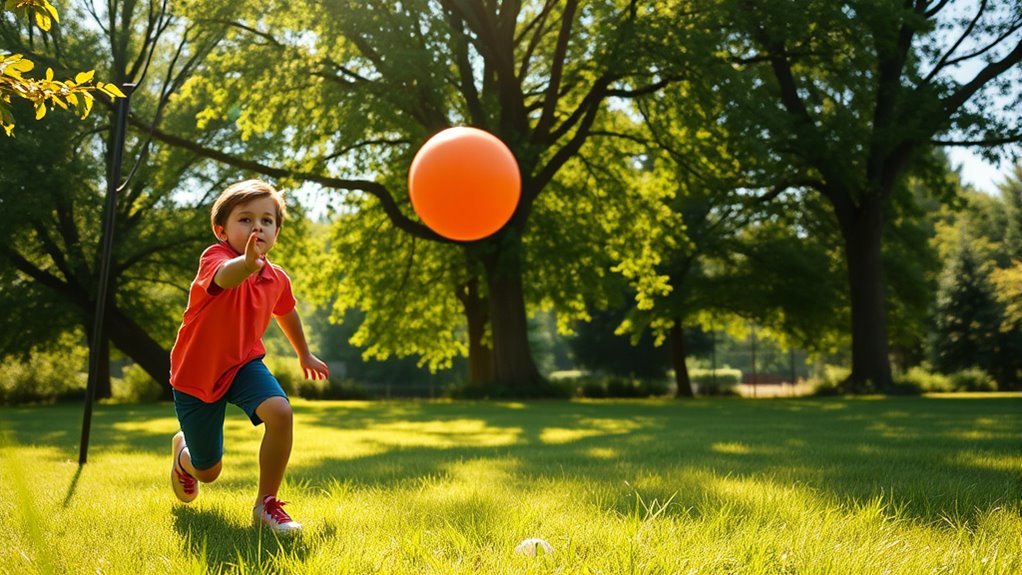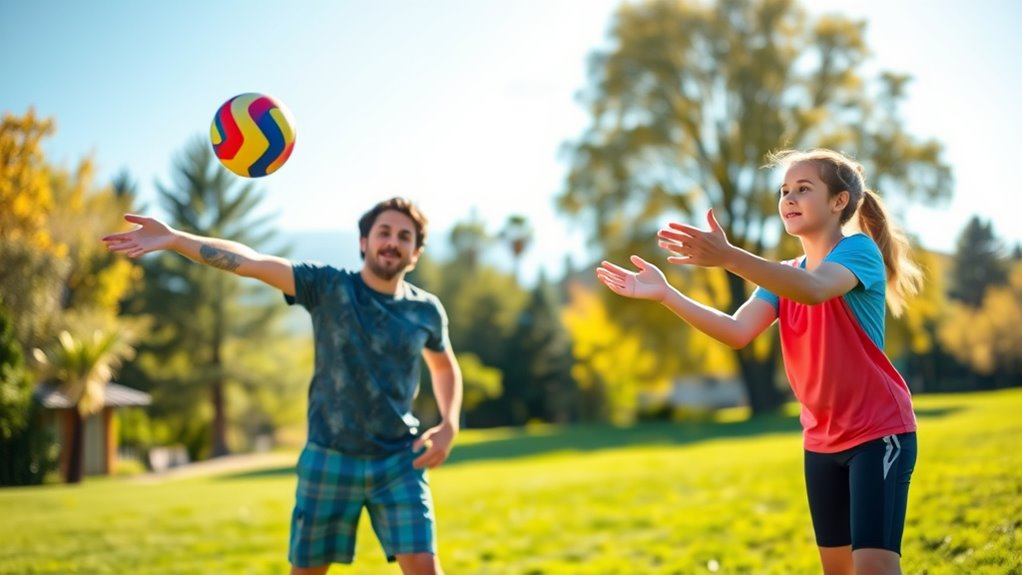To eliminate fear when throwing and catching, start with simple, controlled movements using soft or tennis balls. Focus on tracking the ball, keeping your eyes on it, and practicing with both hands to boost coordination. Keep your motions smooth and relaxed, and gradually challenge yourself with different distances and speeds. Consistent practice builds confidence and skill, so sticking with it will make these fundamentals feel natural—if you keep going, you’ll master the basics with confidence.
Key Takeaways
- Practice controlled throws and catches with soft or tennis balls to build confidence gradually.
- Focus on tracking the ball’s movement and keeping your eyes fixed on it from release to catch.
- Maintain relaxed muscles and steady breathing to reduce tension and enhance coordination.
- Use consistent release points and smooth motions to improve accuracy and control over time.
- Progress by increasing throw speed and difficulty gradually to boost skill and confidence steadily.

Have you ever wondered how to throw and catch a ball effectively? Mastering these skills begins with understanding some basic principles of ball control and hand-eye coordination. When you focus on controlling the ball, you develop a better sense of how it moves through the air and how to position your hands for a successful catch or throw. Hand-eye coordination is essential because it helps you track the ball’s trajectory and react quickly, making your movements more accurate and confident.
To improve your ball control, start by practicing simple throws with a soft ball or even a tennis ball. Hold the ball comfortably in your hand, and aim to throw it with a smooth, controlled motion. Focus on keeping your wrist firm and your arm steady as you release the ball. The goal is to develop a consistent release point so your throws become more accurate over time. As you get better, try varying the distance and speed of your throws to challenge your control. Remember, the more you practice, the more natural it will feel to manage the ball’s movement.
Practice controlled throws with a soft or tennis ball to improve your accuracy and confidence.
Hand-eye coordination can be sharpened by doing targeted exercises. For example, toss the ball gently in the air and catch it with both hands, paying attention to how the ball moves and adjusting your hand position accordingly. You can also practice bouncing the ball against a wall and catching it, which forces you to track the ball’s movement and time your catch precisely. When you catch the ball, try to absorb the impact by slightly giving with your hands, which helps maintain control and prevents the ball from bouncing away. Keep your eyes fixed on the ball from the moment it leaves your hand until it lands in your grasp. This focus helps your brain process the ball’s speed and trajectory more effectively. Additionally, understanding vetted product reviews can help you select the right equipment to support your practice sessions.
As you progress, challenge yourself by catching and throwing with one hand, or by increasing the difficulty with faster or more unpredictable throws. Remember that good ball control and hand-eye coordination don’t develop overnight; they improve gradually with consistent practice. Keep your movements deliberate and pay close attention to how your body responds. Stay relaxed, breathe steadily, and avoid tense muscles, which can hinder your coordination. Whether you’re playing casually or preparing for a sport, these foundational skills will boost your confidence and help you enjoy the game more. With patience and persistence, you’ll find yourself throwing and catching with greater ease, turning fear into fun.
Frequently Asked Questions
How Can I Improve My Hand-Eye Coordination Quickly?
To improve your hand-eye coordination quickly, start with visualization techniques, imagining successful catches and throws to build mental focus. Incorporate hand strengthening exercises like squeezing stress balls or using grip trainers to boost control and dexterity. Practice with small, quick drills, such as tossing a ball against a wall, to develop reflexes. Consistent effort with these methods will enhance coordination faster, making you more confident and precise in your movements.
What Are Common Mistakes Beginners Make When Throwing?
Ever notice how many beginners miss their target? It often comes down to throwing technique and grip adjustment. You might be holding the ball too tightly or using an inconsistent motion. Focus on a smooth, controlled throw, and adjust your grip for better accuracy. Avoid rushing your release or overthinking your form; instead, practice slowly and consciously, refining your technique with each throw to improve quickly.
How Do I Choose the Right Type of Ball for Beginners?
When choosing the right ball for beginners, focus on ball material and size. Opt for a lightweight, soft ball made of rubber or foam, which is easier to grip and control. A smaller ball, around 8-10 inches in diameter, helps build confidence and improves coordination. Avoid heavy or hard balls, as they can cause discomfort or injury. Select a ball that feels comfortable and manageable to encourage consistent practice.
What Safety Precautions Should I Take During Practice?
During practice, you should prioritize safety by wearing protective gear like gloves or helmets if needed. Always keep a safe distance from others to avoid accidental hits, and make sure the area is clear of obstacles. Stay alert and communicate with your partner to prevent surprises. These precautions help prevent injuries and create a safe environment for everyone involved, so you can focus on improving your throwing and catching skills confidently.
How Can I Stay Motivated to Practice Regularly?
You can stay motivated by adopting mindset strategies that turn practice into an exciting adventure. Visualize yourself as a superstar, nailing every catch and throw, which fuels your passion. Set clear, achievable goals that feel like climbing a mountain of success—each milestone a victory. Regularly remind yourself of the joy and progress, making practice feel less like a chore and more like an exhilarating journey toward mastery.
Conclusion
Now that you’ve mastered throwing and catching basics, don’t let doubt dampen your determination. Practice persistently, and you’ll progress quickly. Remember, patience and persistence pair perfectly with play—making mastery manageable and more fun. Keep catching confidence, and soon you’ll conquer challenges with confidence and clarity. So, stay steady, stay strong, and enjoy the journey from beginner to better. With consistent commitment, you’ll turn fear into freedom and fun into finesse!









